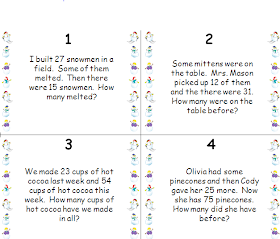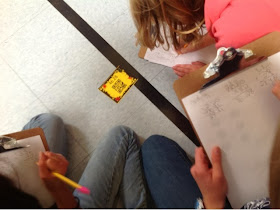These addition and subtraction situations that I am talking about come directly from Table 1 in the Common Core glossary. If you haven't yet seen this check it out below! First graders are also responsible for all these problem types, but with smaller numbers. Check out these great penguin themed problems representing all 12 problem types for help meeting this standard with first graders! Second and third graders are responsible for all of these using 2 and 3 digit numbers. It is a big job and requires some practice, especially if your students are not used to so many different situations.
When most teachers write story problems for their students, they tend to only represent 2-3 of the problem types. I think I was guilty of this several years ago so the kids I currently have in second and third grade probably didn't get the exposure to all the different types of problems they should have when they were younger. Now I do a better job with younger kids and hope it will pay off down the road!
Anyways, here is what I have been working on for my current second and third graders to give them more practice with these ideas.
Winter Themed Addition and Subtraction Word Problems Task Cards
There is something about a seasonal theme that works with this bunch of kids so I am sticking with it. I wrote 16 different task cards representing all 12 of the Common Core addition and subtraction equations.
Take a look!
Check out this post about how I use task cards in the classroom!
I also like to follow up task cards with some formative assessment so I created some follow up questions to see how kids are doing independently on these types of problems.
Want to win a free copy? The first 3 folks who leave a comment below with their email address and their favorite tip for using task cards will get the full set for FREE!!!






































